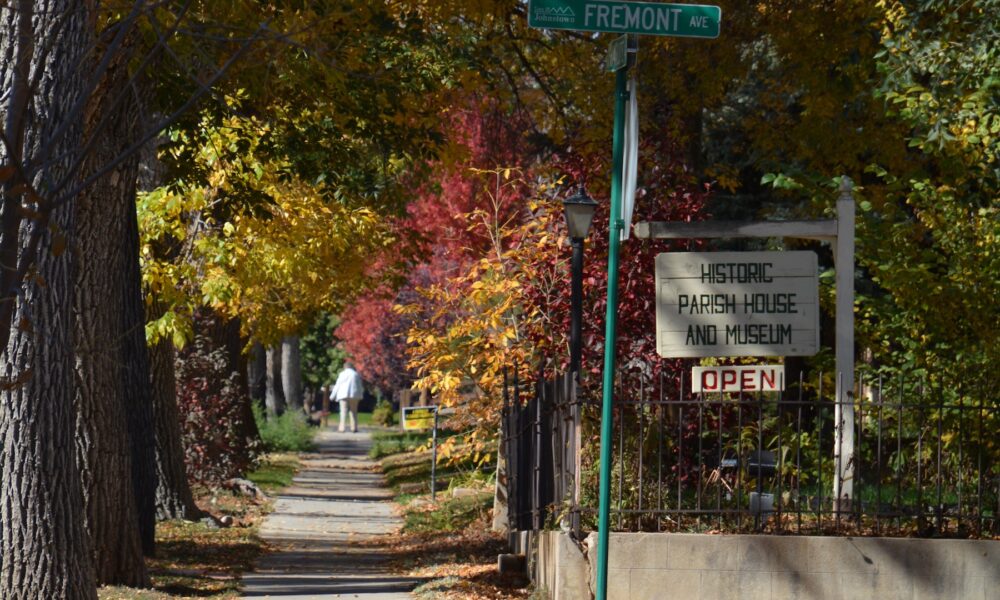Before You Begin
Tour Stops
- 701 Charlotte – Historic Parish House and Museum
- 707 Charlotte – Lottie Parish House
- 809 Charlotte – Former Dilley Chapel
- 10, 12, and 14 S. Fremont – GW Sugar Co. Housing
- 618 Charlotte – W.E. Letford House
- 612 Charlotte – Dr. Glenn A. Jones House
- Original locations of Union High School and Johnstown High School
- 417 Charlotte – School bus garage, “Bus Barn”
- 420 Charlotte – Methodist Episcopal Church (Now the Hope Center)
- 416 Charlotte – Former ME Church Parsonage
- 408 Charlotte – Early 1900s Arts & Crafts Home
- Hillsboro Ditch
- 5 S Raymond – Grain Elevator (Now a residence)
- Johnstown Hotel (Now a residential duplex)
- Masonic Temple (Now a residence)
- 112 Charlotte – Original Fire Station
- 101 Charlotte St – Fairbairn & Parish Hardware & Lumber (now Senior Center)
- 16 N Parish – Blacksmith Shop (now Precision Family Eyecare) and Rowden’s Filling Station
- 27 N Parish – Colorado Soap Company (formerly north of 21 N. Parish Ave.)
- 1 N Parish – W.H. McCormick Mercantile Co.
- Downtown – East Side and West Side
- 106 E South 1st St – Giesler Opera House & Sinclair Station
- 221 W South 1st St – J.K. Barnard Home
- 310 W South 1st St – Mohawk Condensed Milk Company (Now Uniscope, Inc.)
- 25 S. Denver – First Baptist Church (Now Cowboy Church)
1. 701 Charlotte – Historic Parish House and Museum

This Craftsman-style bungalow was the last of the homes built and lived in by town founder Harvey Parish and his wife Mary. It was built in 1914 for $3,750 and is the only masonry-constructed Arts & Crafts style of architecture in Johnstown. It was built with electric wiring, three bathrooms, a fireplace in the front parlor with leaded-glass cabinets on each side, and a mantle that extends across the entire wall.
The Town of Johnstown purchased the property in 1998 and the Society worked to have the property listed on both the Colorado and the National Registers of Historic Places. The main floor recreates life in the early 1900s when the Parishes lived there; the basement and Visitor’s Center feature additional museum displays. It also serves as the Society’s office.
2. 707 Charlotte – Lottie Parish House
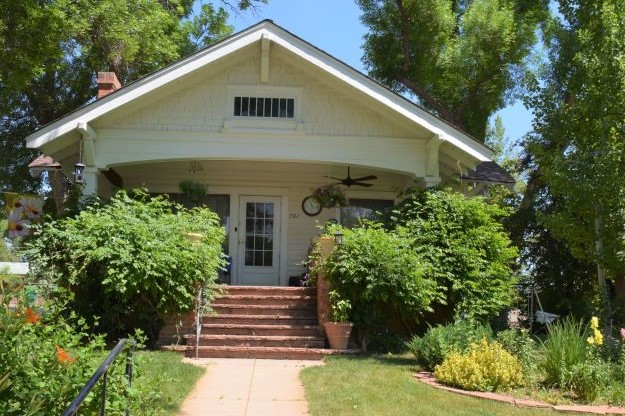
Harvey and Mary Parish’s only daughter, Charlotte (Lottie) Belle, lived in this home with her husband Sam Parkin, a local businessman. Harvey gifted the property to Lottie in October 1913, the month she and Sam married. Lottie and Sam had three daughters: Myrna, Genevieve, and Elizabeth Ann.
3. 809 Charlotte – Former Dilley Chapel
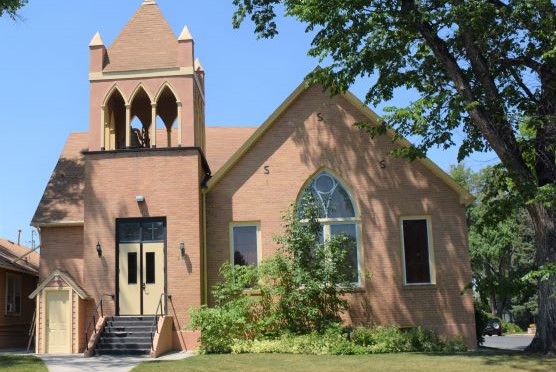
Behind the brick veneer of this remodeled church building is the skeleton of what was once the Dilley Chapel (Evangelical United Brethren Church) originally located at Elwell. It was the area’s first church, built in 1894 at the entrance to what would become the Elwell Cemetery (now Johnstown Cemetery). Until then, church services were held in country schoolhouses, often located on farms along main county roads.
Reverend Cora M. (Elwell) Dilley was one of the circuit-riding preachers for the EUB church back then, and she served the White Hall School congregation and others. The local community that grew up around the Dilley Chapel was given Cora’s maiden name, “Elwell.” The original church building was destroyed by fire in 1904 and rebuilt the next year. In 1927, it was moved to this location in Johnstown. The basement was dug while the ground was still frozen and dynamite was used to loosen it. The church was cut into two parts for the move and, once reset in its new location, the brick veneer was added. The building served as a church until 2018 when it was sold and is now privately owned.
4. 10, 12, and 14 S. Fremont – GW Sugar Co. Housing

The Great Western Sugar Company built this tri-plex in 1920 as housing for company supervisors. The factory was located between Johnstown and Milliken on CO Hwy 60. It served to stabilize the community by providing long-term employment for local Johnstown and Milliken residents.
5. 618 Charlotte – W.E. Letford House

Willard E. Letford was born in Minnesota in 1875. In the early 1890s he was told by a doctor that he had tuberculosis and was advised to go to either South America or Colorado, but regardless, he wasn’t supposed to live to see his 21st birthday – he lived to be 84. Letford moved to Longmont, CO in 1892 and married Leona Kitely in 1901. They moved to Johnstown in 1904 where he and T.M. Callahan (of Longmont) started the first private bank in Johnstown.
Letford helped persuade the Mohawk Milk Condensery (Site 25) and the Great Western Sugar Company to locate in Johnstown, thus creating long-term economic stability to the young town. Before his death in 1959, Letford Elementary School was built and named in his honor. It was demolished in 2023, and the school’s successor is Elwell Elementary School, located across Hwy 60 from the former Elwell community.
6. 612 Charlotte – Dr. Glenn A. Jones House
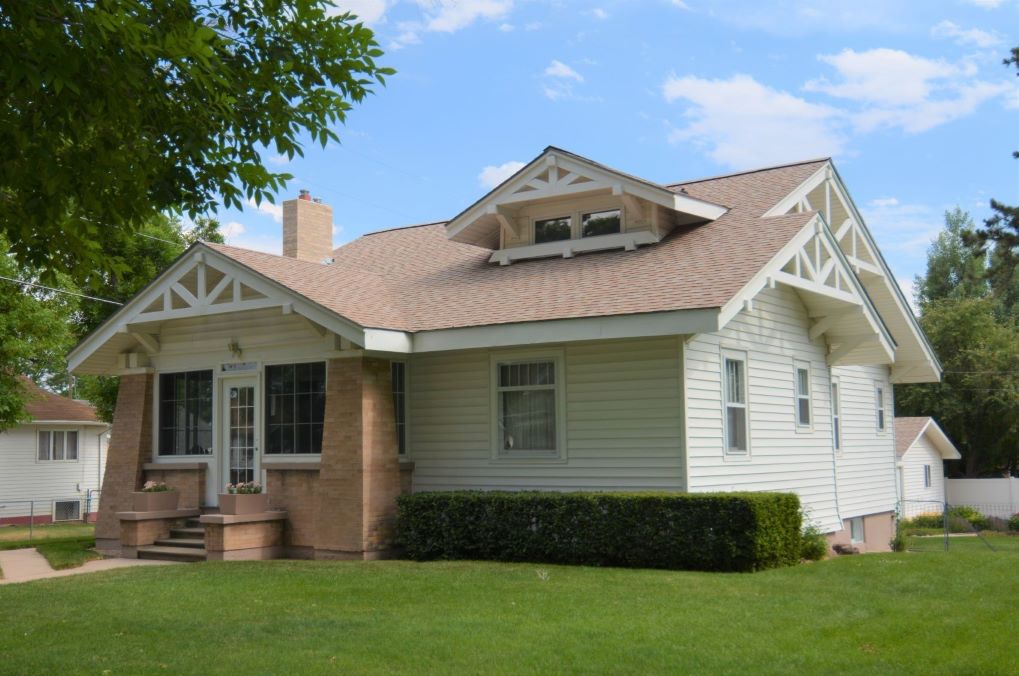
Glenn Albert Jones was born in 1892 in South Dakota. He received his medical license to practice in Colorado in 1920 and started to look for a location to practice. He visited several towns in Colorado and then went to visit his friend, Dr. Haskell, in Windsor who told him about a community 10 miles south called Johnstown. Since there was no passenger service Jones walked here, and as he reached the top of the hill north of town he gazed upon the beautiful valley and he thought it was “God’s Spot”. He secured lodging that evening and later made arrangements to rent two rooms in the Eureka Building downtown, bought supplies, furnished his office, bought a Model T Ford, and began his practice in the fall of 1920.
Dr. Jones often worked alone and when his patients were seriously ill, he spent many a night in their homes to watch over them. To stop contagious diseases among children, he established a free pilot school immunization program, which later developed into a statewide initiative. In addition, he played a key role in securing a full-time school nurse for the public schools. Later, he continued his medical practice from his home at this Charlotte Street location. After his death in 1961, his wife Dorothy wanted to fulfill a dream to have a library dedicated in his honor, and this became a reality in 1968 when our library was named the Glenn A. Jones, M.D. Memorial Library.
7. Original Locations Johnstown High School and Union High School
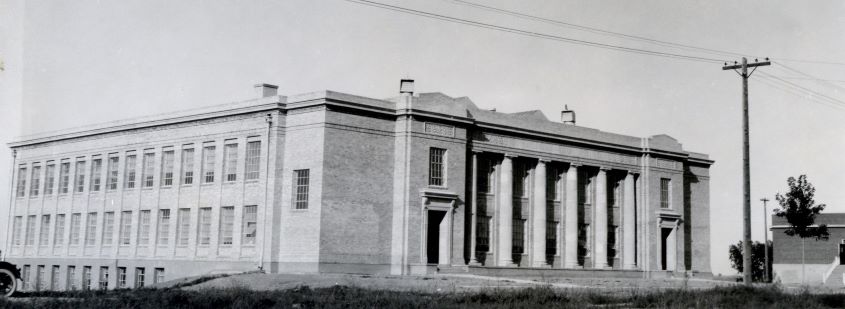
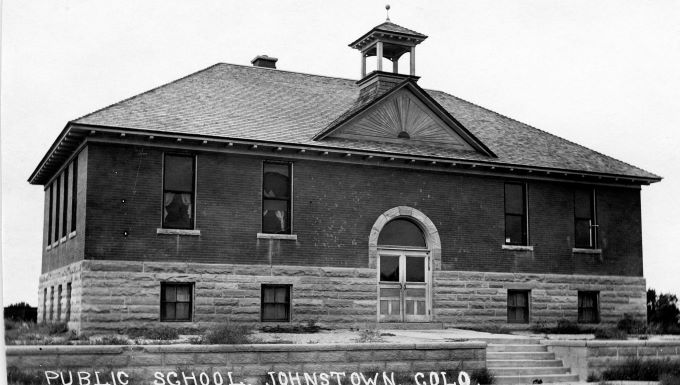
From the NE corner of Charlotte and Estes, the corner lot once sported tennis courts used by Johnstown High School and the public. Next to the courts was Johnstown High School, and then Union High School – Johnstown’s first school building, which accommodated all grades – sat between the high school and the bus garage (now Little House restaurant). If you look closely as you walk down the hill, you can see the school’s original steps next to the former bus garage (Site 8).
Johnstown High School
Johnstown High School In the spring of 1922, the new high school building was completed and all the high school students carried their books and materials over to the new building from the remodeled grade school (Union High) next door to the east.
Elva (Gray) Shultz wrote in 1932 that she recalled as a student there that “The new building seemed like a palace. It was so large and light. The arched hallway on the first floor was so unusual it made me catch my breath. That was a natural reaction when you realize the building cost $150,000.” The new school was a two-story blonde-brick building of Italian Renaissance architecture and was used from 1922-1967. The school district was consolidated in 1962, and students from Johnstown and Milliken High Schools attended school together at Theodore Roosevelt High School at 616 N. 2nd St (now Roosevelt Middle School). The new Roosevelt High School opened in 2023 at 3349 Roosevelt Parkway.
Johnstown Union High School
Johnstown Union High School was the first school built in 1904. The square four-room brick school building was erected on the hill at about Charlotte St. and St Charles Ct. It had two rooms upstairs and two downstairs. It wasn’t long before the school became too crowded for efficient learning, and in 1918, it was remodeled into a grade school. Union High School was dissolved in 1920 after Johnstown High School was erected on the west side of it.
8. 417 Charlotte – School Bus Garage, “Bus Barn”
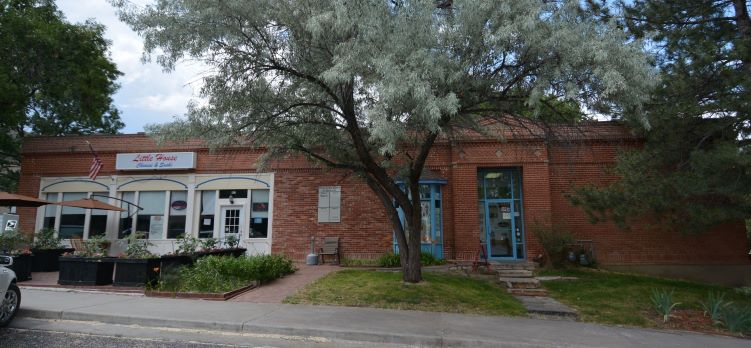
This brick building was the school bus garage. Beginning in September 1915, children were “bussed” from their homes to school in wagons made especially for the purpose of transporting the early learners. Each wagon had a seat running the entire length of the wagon bed on each side and would seat approximately 20 students. Curtains enclosed the ends and sides in case of inclement weather. Later, Model A school busses replaced the horse-drawn wagons and they were housed in this building. See Site 19 for a look at the shiny new buses.
9. 420 Charlotte – Methodist Episcopal Church (Now the Hope Center)
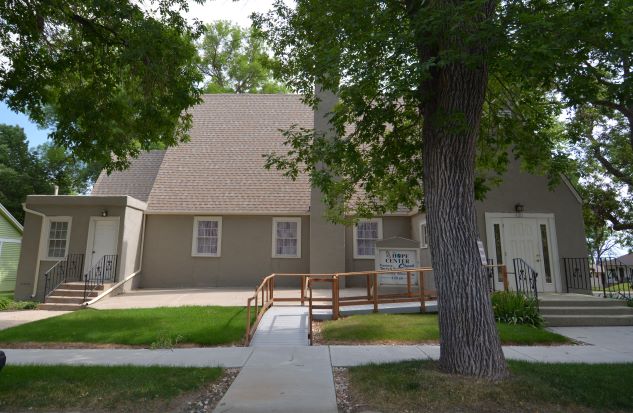
The first church built in Johnstown was the Methodist Episcopal Church in 1904 on this site. The church used trestle, nail kegs, and boards for seats and was later destroyed by fire in January 1932. With the help of donated work and generous contributions, the “new” church was built, and dedicated five months later.
In June 1967, the Evangelical United Brethren and Methodist Episcopal churches merged. This merger anticipated the union of the two denominations nationally in June 1968. The united congregation continued to hold services in the old Dilley Chapel (Site 3) until October 1974 when the United Methodist Church was completed at 108 King Ave. in the Country Acres subdivision. The Dilley Chapel was then sold to the congregation of St. John the Baptist Catholic Church, and the Methodist Episcopal church building was sold to the Assembly of God congregation (now the Hope Center).
10. 416 Charlotte – Former ME Church Parsonage

This Arts and Crafts home, built in 1925, served as the Methodist church parsonage. It replaced a small square house built in 1906 that was moved off this lot to make room for the larger current house. The first pastor to occupy the house was Mr. E.E. Brace, followed by numerous other pastors over the years. In the early 1970s, the Methodist church bought land for a new building in the Country Acres subdivision and is still at that location today.
11. 408 Charlotte – Early 1900s Arts & Crafts Home
This house is one of the few two-story homes built in the early 1900s on Charlotte St. It was built in 1909 and the building behind the house, also two stories, was built in 1918. This home has had numerous owners over the years, including members of Johnstown’s earliest families – G.U. and Effie Anderson and the Bender and Wailes families. The property was also owned by the Colorado Milling & Elevator Company in the 1920s.
12. Hillsboro Ditch

There’s a popular saying about this region that states, “The three most important things about living in the West are: water, water, and water.” And farmers and ranchers who flocked to this region in the late 1800s quickly learned this lesson. Congress passed the Homestead Act in 1862, which granted 160 acres to anyone willing to try their luck in the west, but hopeful settlers often came up empty handed after a series of droughts wreaked havoc on the Great Plains in the 1880s. Obviously, different measures would be necessary to make this area blossom.
Town founder Harvey Parish grew up learning about irrigation farming from his father and eventually possessed a great deal of practical knowledge of ditch building and operation. It was said he was known as “The Water Wizard” and he worked with others to build the Hillsboro Ditch in front of you. The ditch originates East of Loveland, winds through farmland, and terminates in Milliken. Harvey Parish is also the namesake of this park (Parish Park).
13. 5 S Raymond – Grain Elevator (Now a residence)

The Great Western Railway tracks alongside this property supplied grain to this elevator on what was then the Western edge of the original Johnstown plat in 1902. It operated under a few different names including Johnstown Feed and Seed and Ranch-Way, Inc. The property was purchased in 2019 by a private owner who is renovating the structure into a unique home.
14. Johnstown Hotel (Now a residential duplex)

The Johnstown Hotel once stood on the SW corner of Charlotte and Rutherford. The hotel, originally called the Horner Hotel, was built in 1902 by Monty Tucker and faced Rutherford Ave. The Fairbairn & Parish Hardware & Lumber Company (Site 18), kitty-corner to the hotel, and the hotel itself, were the first two commercial buildings constructed, and both served many of Johnstown’s first residents by offering a temporary place to stay and the means to purchase materials one would need to build a house in this brand-new town. The hotel had various owners over the years, and eventually was renovated in to apartments. The building burned down in the wee hours of the morning on February 12, 1957. The brick duplex now in this location was built in 1960.
15. Masonic Temple (Now a residence)

On October 7, 1911 the “Johnstown Fraternal Association” was formed at a meeting called by H. J. Parish in his office, which paved the way for the Masonic Temple to eventually become a reality. The Temple was dedicated in 1928. This building is now privately-owned as a residence.
16. 112 Charlotte – Original Fire Station

The original fire station was housed here next to the alley. In 1908, Johnstown leaders bought two-dozen buckets, ladders and axes to be used to protect Johnstown’s original wooden stores. A public notice on Aug. 20,1908 read:
To Johnstown Fire Department: In case of fire, several dozen tin pails, two axes and two extension ladders can be found stored in a wareroom just north of the old Morrison Black Smith Shop. The key will be left at the Davis-Hartford Store, or a 2×4 may be used to break in a front window. Outside towns may smile at our fire department’s equipment, never the less the department did excellent service at the recent fire. Please do not forget the place and hold yourselves ready to defy any blaze in any part of the city. I thank the department for their most excellent services at the recent fire.
H.J. Parish, Mayor.
The town employees were responsible for fighting the fires. Hose carts were used to carry equipment and a “locomotive tire” was used as the town alarm. In 1924, the first official Johnstown Volunteer Fire Department was organized with 20 members. The town bought its first truck in 1945. The 25 fire department volunteers made the large building at 310 S. 1st St. (H&R Towing) into a firehouse in 1957, and the fire station moved to its current location on Telep Ave. north of Hwy 60 in 1998.
17. 101 Charlotte St – Fairbairn & Parish Hardware & Lumber (now Senior Center)

In October 1902, Johnstown featured its first business here on this site: the Fairbairn-Parish Lumber and Mercantile Company, which was built from lumber hauled from Berthoud and comprised a 24’ x 50’ structure. They sold grain, farm implements, hardware, coal, and wire. The property served as a lumber company over the years under various owners. In 1977, under the ownership of Woody Collins, fire destroyed the building and affected the building to the north (Site 18). It was ruled arson; the arsonist was never found. Collins sold the property to the Town of Johnstown, and a new building was erected much later that first served as the Johnstown Town Hall until the new town hall was built at 450 S. Parish Ave in the early 2000s. This building now serves as the Johnstown Senior Center.
18. 16 N Parish – Blacksmith Shop (now Precision Family Eyecare) and Rowden’s Filling Station
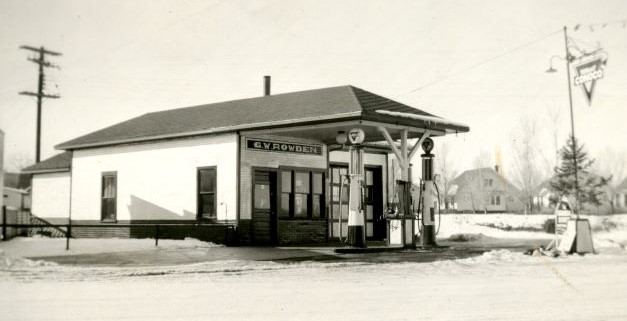
This location first served as A.R. Morrison’s blacksmith shop in the early 1900s. It was situated just north of what is now the Senior Center (Site 16). Rowden’s filling station was to the north of it where the pocket park is now.
19. 27 N Parish – Colorado Soap Company (formerly north of 21 N. Parish Ave.)
The October 12, 1922 edition of the Johnstown Breeze announced a new industry – The Colorado Soap Company was moving to Johnstown. And, indeed, the factory did come, much to the painful memory of many of the old timers who invested in the company. The new building on “Main” St. (N. Parish Ave) was the very latest in factory construction. It was conveniently arranged, well-lighted, and steam heat was installed.
Over 7,000 ft of floor space provided room for the most modern, labor-saving machinery to mix and box soap. The machinery was to arrive soon. The factory promoters were two young gentlemen with well-dressed beautiful wives and darling children. They promised a beautiful financial dream for only a few dollars investment. Many people jumped at the chance with visions of dollar signs and a boom for Johnstown.
One night, however, the businessmen left town and the investors were left “holding the bag” – no money, no soap. The building was later converted to an alcohol plant and much of it was destroyed by fire in 1945. What was left of the building was used by various businesses since. It was demolished in 2019.
20. 1 N Parish – W.H. McCormick Mercantile Co.
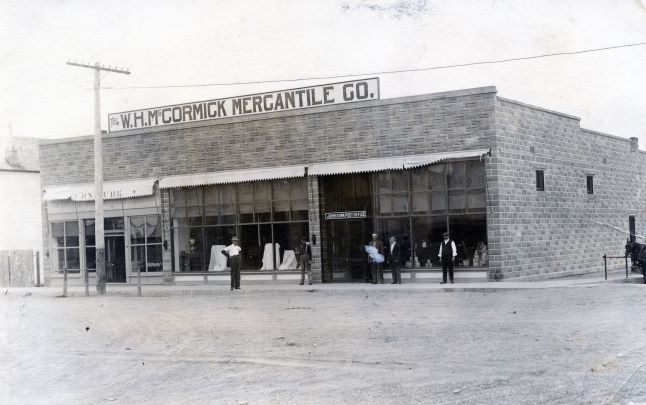
J.J. Becker sold part of his land to J.L. Niebergall Mercantile in 1904. In 1909, W.H. McCormick of Berthoud opened a branch of his “McCormick Sells Everything” mercantile in this location. He also operated McCormick Harvesting machines in the rear of the building. This later became McCormick Mercantile. Through the years the building was used as a car dealership, carpenter shop, variety store, and a drug store in 1970.
21. Downtown – West Side
As you look around you see modern Johnstown, but try to visualize the way it looked in the early 1900s. Many of the original buildings were made of wood, and stores generally used coal and wood burning stoves for heat. Several fires destroyed some of the original buildings and they were replaced with brick. Cement sidewalks were then laid in 1909, and local residents enjoyed a domestic water pipeline by 1912.
2 S Parish – Davis-Hartford Mercantile Co.
This building was also used as a Post Office, Town Hall, school, and a meeting place for lodges and churches. It was destroyed by fire in 1910. Later, it was the site of the Johnstown State Bank, and later the First National Bank of Johnstown. For most of its early history, Johnstown had only one bank – the First National Bank of Johnstown. It started in 1904 as a private bank founded by W.E. Letford and T.M. Callahan. In December 1907, the bank was nationalized and became First National Bank of Johnstown.
In 1916, a new bank, the Johnstown State Bank, constructed this building and was in competition with First National. At that time, First National was located at 16 S. Parish Ave. After only two years, the State Bank went out of business and First National bought the building. The First National Bank resided in this building from 1918 until 1997 when it moved to its new building at 100 Johnstown Center. In 2000, The First National Bank of Johnstown was bought by Union Colony Bank.
10 S Parish – Theater
This location served as Johnstown’s theater from 1943-1956. You can see the theater’s overhead marquee in the photo. It operated under different names, including the Lake Theater. Other uses of the building included the post office and a grocery store.
16 S Parish – First National Bank of Johnstown
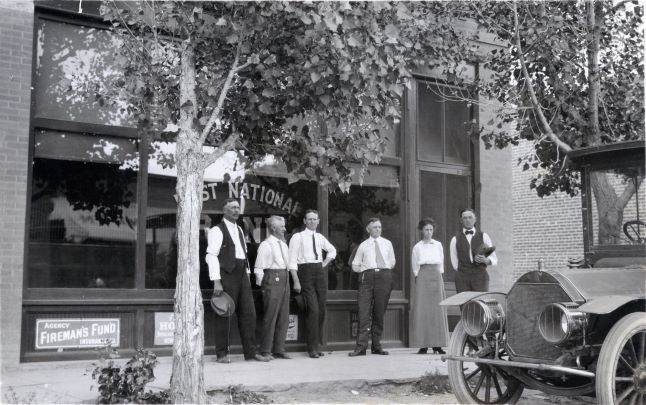
This was the location of the First National Bank of Johnstown’s second building. They used this location at the time they were in competition with Johnstown State Bank. They later moved north to 2 S. Parish Avenue.
21. Downtown – East Side
3 S Parish – Reeder & Ballentine Drug Store

Johnstown’s first drug store operated at this location from 1906-1916.
7 S Parish – Jud Martin Soda Fountain
In addition to being the home of many cafes, this building held Jud Martin’s Soda Fountain. George Oliver “Jud” Martin came to Johnstown in 1920. He ran various businesses including a pool hall and clothing store. At the soda fountain, Jud dipped 50-75 gallons of ice cream a week. Children were always welcome and it wasn’t unusual to see them sleeping on chairs and benches waiting for their parents. Jud also coached the Johnstown Juds baseball and softball teams. They won state titles in 1938, 1950, and 1952. Jud also served as Johnstown’s mayor from 1941-1948.
13 S Parish – The Johnstown Breeze & Public Service Company
This location was where J. Gordon Smith first published the Johnstown Breeze in 1904. The Breeze is still in publication today and is located at 8½ S. Parish Ave. Starting in 1914, the space next to the Breeze was home to various public service companies such as Fort Lupton Light and Power Company and Colorado Central Power Company.
19 / 19½ S Parish – Eureka Block Building
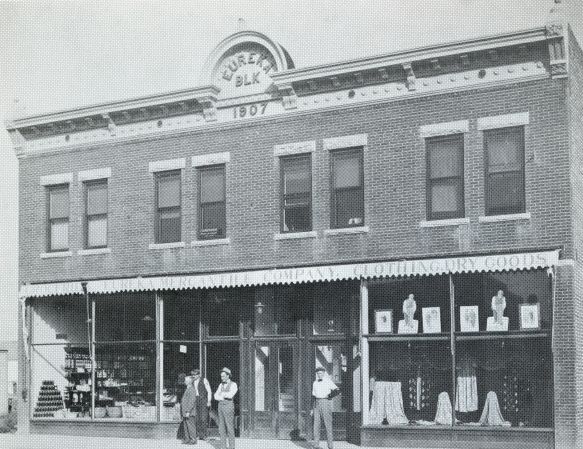
The Eureka Block building was constructed in 1907 for $7,000. It is an exact duplicate of the Yancey Block building in Windsor, built by A.M. Felmlee in 1905. That building was the largest and most architecturally sophisticated building Felmlee ever constructed.
William Parkin, a Johnstown businessman and entrepreneur, was so impressed with that building he hired Felmlee to construct a replica in Johnstown at this location. Parkin named the building the Eureka Block and initially operated his Eureka Mercantile from the north side of the 2-store building. His son Sam Parkin operated a dry goods and grocery store from south side. Later, this building was occupied by Jud Martin’s Pool Hall, lawyers, doctors – including Glenn A. Jones, M.D. (Doc Jones), and dentists, and Leo’s Bar and Grill, which operated for many decades until The Black Sheep Coffee & Crepes bought the building in 2019.
21 S Parish – Hays Market
From 1955 to 1976, this building was home to Hays Market. Thurman and Louisa Hays moved to Johnstown in 1928. They chose Johnstown because Louisa’s brother was engaged in a brokerage firm, which had purchased the McCormick Mercantile Company (Site 20) and was in the process of closing it. In 1929, Thurman and Louisa purchased the remaining mercantile stock, partitioned off the building, and started Hays Mercantile. This was the beginning of the present Hays Market.
They moved to 18 S. Parish Ave prior to expanding to this location at 21 S. Parish Ave. Hays Market is currently located at 201 Johnstown Center and continues to be a Hays family owned and operated business.
22. 106 E South 1st St – Giesler Opera House & Sinclair Station

On January 15, 1914 John D. and Mattie I. Giesler bought this property and built the Giesler Opera House here. It was used for live theater groups, concerts, vaudeville acts, silent films, basketball, and a community center. In 1935, the opera house was torn down to build the Beeten Brothers gas station. The outside form of the opera house was used to build the station, and the maple floor of the opera house was used as the floor in the lobby of the station. The basketball flooring was used as the wall for the grease rack and for the garage section of the station. It was eventually torn down and sat vacant for several years. Today, it houses a Sinclair gas station and convenience store.
23. 221 W South 1st St – J.K. Barnard Home

The J. K Barnard family moved to Johnstown in 1903 from north of Pueblo when J. K. was hired by the Great Western Railroad to lay and maintain tracks connecting beet dumps and the area’s sugar factories. There were six children in the family: Eva, Darrell, Nell, Floy, Rae, and Karl. They lived in this house built by the Great Western for them.
The one room school house Nell and Floy attended – Smith School – was a mile south of town. In 1902, It was moved to town and onto the back of this lot. It was used for the elementary grades while the upper grades met in the town hall. Later, a red brick school house was built on the hill (see Site 7), and Johnstown Union High School was organized. The new building accommodated all grades through high school.
24. 310 W South 1st St – Mohawk Condensed Milk Company (Now Uniscope, Inc.)
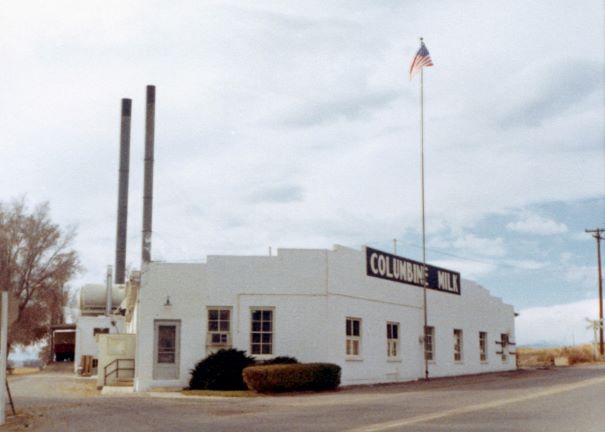
In 1910, area businessmen and farmers organized the Colorado Condensed Milk Company. The Mohawk Condensed Milk Company agreed to support the local endeavor and completely take over the operation once a prescribed volume of milk was delivered to the plant each day. To meet the demand, large numbers of dairy cows were shipped to local farmers from Wisconsin and Minnesota.
Before long the anxious sponsors of the plant could relax, as the transplanted cows in Johnstown filled the requirement and the facility was turned over to Mohawk. Even so, Mohawk continued to use the name Colorado Condensed Milk Company for its Johnstown factory. It operated as such until 1921 when the Carnation Milk Company bought out Mohawk, and was later named Columbine Milk Co. The plant closed in 1977 after having provided stable jobs in Johnstown for 66 years. Uniscope, Inc. purchased the building in 1979.
25. 25 S. Denver – First Baptist Church (Now Cowboy Church)
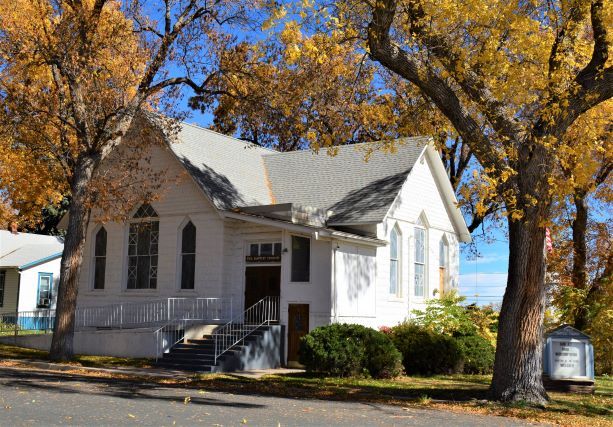
The Welcome Hill schoolhouse was just past the wide curve heading north on Parish Ave out of town. It was there on the east side of the road that a few families met for church services on Sundays before churches were built in Johnstown. From this nucleus came the First Baptist Church of Johnstown, and members were baptized in the Big Thompson River until this building was erected. The cornerstone was laid in 1908 and the building dedicated in 1909.
This concludes the Old Town Johnstown Walking Tour.
Resources
Healy, Rebecca S. A Tribute to Johnstown, 1977.
Scamehorns, Rosslyn and Lee. The Callahan’s of Longmont, The Family and the House.
The Johnstown Breeze. Various articles.
Thomas, Adam. Historitecture, LLC., The Struggle for Identity: Windsor’s Historic Downtown, for the Town of Windsor, CO SHF project 2007-M2-016, January 2010.
Weld County Clerk and Recorder.

